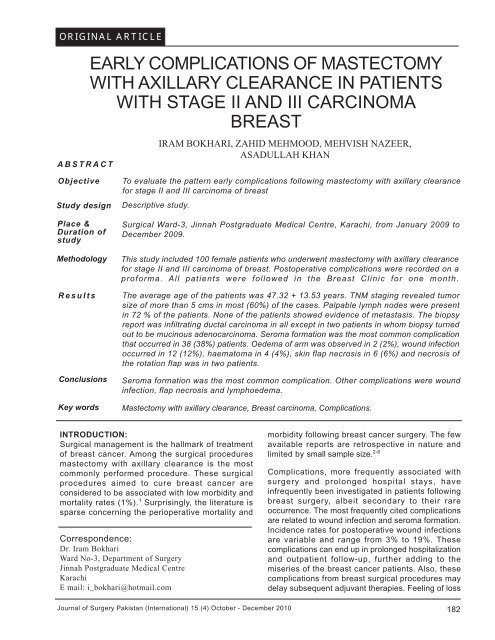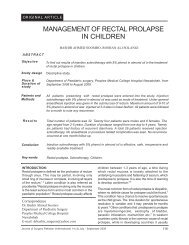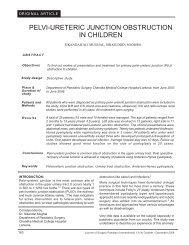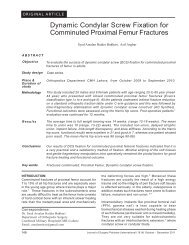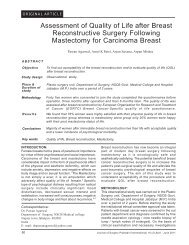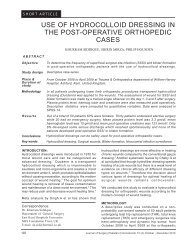early complications of mastectomy with axillary clearance in patients ...
early complications of mastectomy with axillary clearance in patients ...
early complications of mastectomy with axillary clearance in patients ...
You also want an ePaper? Increase the reach of your titles
YUMPU automatically turns print PDFs into web optimized ePapers that Google loves.
ORIGINAL ARTICLEABSTRACTEARLY COMPLICATIONS OF MASTECTOMYWITH AXILLARY CLEARANCE IN PATIENTSWITH STAGE II AND III CARCINOMABREASTIRAM BOKHARI, ZAHID MEHMOOD, MEHVISH NAZEER,ASADULLAH KHANObjectiveStudy designPlace &Duration <strong>of</strong>studyMethodologyResultsConclusionsKey wordsTo evaluate the pattern <strong>early</strong> <strong>complications</strong> follow<strong>in</strong>g <strong>mastectomy</strong> <strong>with</strong> <strong>axillary</strong> <strong>clearance</strong>for stage II and III carc<strong>in</strong>oma <strong>of</strong> breastDescriptive study.Surgical Ward-3, J<strong>in</strong>nah Postgraduate Medical Centre, Karachi, from January 2009 toDecember 2009.This study <strong>in</strong>cluded 100 female <strong>patients</strong> who underwent <strong>mastectomy</strong> <strong>with</strong> <strong>axillary</strong> <strong>clearance</strong>for stage II and III carc<strong>in</strong>oma <strong>of</strong> breast. Postoperative <strong>complications</strong> were recorded on apr<strong>of</strong>orma. All <strong>patients</strong> were followed <strong>in</strong> the Breast Cl<strong>in</strong>ic for one month.The average age <strong>of</strong> the <strong>patients</strong> was 47.32 + 13.53 years. TNM stag<strong>in</strong>g revealed tumorsize <strong>of</strong> more than 5 cms <strong>in</strong> most (60%) <strong>of</strong> the cases. Palpable lymph nodes were present<strong>in</strong> 72 % <strong>of</strong> the <strong>patients</strong>. None <strong>of</strong> the <strong>patients</strong> showed evidence <strong>of</strong> metastasis. The biopsyreport was <strong>in</strong>filtrat<strong>in</strong>g ductal carc<strong>in</strong>oma <strong>in</strong> all except <strong>in</strong> two <strong>patients</strong> <strong>in</strong> whom biopsy turnedout to be muc<strong>in</strong>ous adenocarc<strong>in</strong>oma. Seroma formation was the most common complicationthat occurred <strong>in</strong> 38 (38%) <strong>patients</strong>. Oedema <strong>of</strong> arm was observed <strong>in</strong> 2 (2%), wound <strong>in</strong>fectionoccurred <strong>in</strong> 12 (12%), haematoma <strong>in</strong> 4 (4%), sk<strong>in</strong> flap necrosis <strong>in</strong> 6 (6%) and necrosis <strong>of</strong>the rotation flap was <strong>in</strong> two <strong>patients</strong>.Seroma formation was the most common complication. Other <strong>complications</strong> were wound<strong>in</strong>fection, flap necrosis and lymphoedema.Mastectomy <strong>with</strong> <strong>axillary</strong> <strong>clearance</strong>, Breast carc<strong>in</strong>oma, Complications.INTRODUCTION:Surgical management is the hallmark <strong>of</strong> treatment<strong>of</strong> breast cancer. Among the surgical procedures<strong>mastectomy</strong> <strong>with</strong> <strong>axillary</strong> <strong>clearance</strong> is the mostcommonly performed procedure. These surgicalprocedures aimed to cure breast cancer areconsidered to be associated <strong>with</strong> low morbidity andmortality rates (1%). 1 Surpris<strong>in</strong>gly, the literature issparse concern<strong>in</strong>g the perioperative mortality andCorrespondence:Dr. Iram BokhariWard No-3, Department <strong>of</strong> SurgeryJ<strong>in</strong>nah Postgraduate Medical CentreKarachiE mail: i_bokhari@hotmail.commorbidity follow<strong>in</strong>g breast cancer surgery. The fewavailable reports are retrospective <strong>in</strong> nature andlimited by small sample size. 2-6Complications, more frequently associated <strong>with</strong>surgery and prolonged hospital stays, have<strong>in</strong>frequently been <strong>in</strong>vestigated <strong>in</strong> <strong>patients</strong> follow<strong>in</strong>gbreast surgery, albeit secondary to their rareoccurrence. The most frequently cited <strong>complications</strong>are related to wound <strong>in</strong>fection and seroma formation.Incidence rates for postoperative wound <strong>in</strong>fectionsare variable and range from 3% to 19%. These<strong>complications</strong> can end up <strong>in</strong> prolonged hospitalizationand outpatient follow-up, further add<strong>in</strong>g to themiseries <strong>of</strong> the breast cancer <strong>patients</strong>. Also, these<strong>complications</strong> from breast surgical procedures maydelay subsequent adjuvant therapies. Feel<strong>in</strong>g <strong>of</strong> lossJournal <strong>of</strong> Surgery Pakistan (International) 15 (4) October - December 2010 182
Mastectomy <strong>with</strong> Axillary Clearance <strong>in</strong> Carc<strong>in</strong>oma Breast<strong>of</strong> her fem<strong>in</strong>ity, disfigurement, self esteem, health,role and life after <strong>mastectomy</strong> needs furtheremotional and psychiatric support.The aim <strong>of</strong> the current study was to evaluate the<strong>early</strong> <strong>complications</strong> (<strong>with</strong><strong>in</strong> 30 days) follow<strong>in</strong>g<strong>mastectomy</strong> <strong>with</strong> <strong>axillary</strong> <strong>clearance</strong> for establishedcases <strong>of</strong> carc<strong>in</strong>oma <strong>of</strong> breast.METHODOLOGY:This descriptive study was conducted <strong>in</strong> SurgicalUnit-I, Ward-3, J<strong>in</strong>nah Postgraduate Medical Centre,Karachi for one year i.e. from 01-01-2009 to 31-12-2009. This study <strong>in</strong>cluded hundred female <strong>patients</strong>who presented <strong>in</strong> the Breast Cl<strong>in</strong>ic, <strong>with</strong> theestablished diagnosis <strong>of</strong> carc<strong>in</strong>oma <strong>of</strong> breast andunderwent modified radical <strong>mastectomy</strong> <strong>with</strong> <strong>axillary</strong><strong>clearance</strong>. All <strong>patients</strong> were followed <strong>in</strong> the BreastCl<strong>in</strong>ic for one month. Data was analyzed by us<strong>in</strong>gSPSS version 10 on computer. Descriptive statisticslike frequency, percentage, averages etc werecomputed for data presentation.RESULTS:A total <strong>of</strong> 100 <strong>patients</strong> were analyzed to assess thepattern <strong>of</strong> <strong>complications</strong> follow<strong>in</strong>g modified radical<strong>mastectomy</strong> <strong>with</strong> <strong>axillary</strong> <strong>clearance</strong> for establishedcases <strong>of</strong> <strong>early</strong> carc<strong>in</strong>oma <strong>of</strong> breast. Average age <strong>of</strong>the <strong>patients</strong> was 47.32 + 13.53 years (rang<strong>in</strong>g from25 to 74 years). Tumor node metastasis (TNM)stag<strong>in</strong>g revealed tumor size <strong>of</strong> more than 5 cms <strong>in</strong>most (60%) <strong>of</strong> the cases. Palpable lymph nodeswere present <strong>in</strong> 72% <strong>of</strong> the <strong>patients</strong>. None <strong>of</strong> the<strong>patients</strong> showed evidence <strong>of</strong> distant metastasis. Thebiopsy report was <strong>in</strong>filtrat<strong>in</strong>g ductal carc<strong>in</strong>oma <strong>in</strong> allthe <strong>patients</strong> except for two <strong>patients</strong> <strong>in</strong> whom it turnedout to be muc<strong>in</strong>ous adenocarc<strong>in</strong>oma.Table I: Tumor CharacteristicsTNM* Stag<strong>in</strong>g Frequency PercentageT2 (2-5cms)T3 (>5cms)N0 (No node metastasis)N1 (Regional node metastasis)Mo (No distant metastasis)M1 (Distant metastasis)40602872100Nil40%60%28%72%100%-Seroma formation was the most commoncomplication (38%) despite the use <strong>of</strong> suction dra<strong>in</strong>sunder <strong>mastectomy</strong> flaps and <strong>in</strong> the axilla. Oedema<strong>of</strong> arm was observed <strong>in</strong> only two <strong>patients</strong>. Wound<strong>in</strong>fection occurred <strong>in</strong> 12 (12%) <strong>patients</strong>, while 4 (4%)<strong>patients</strong> developed haematoma which wasevacuated. Sk<strong>in</strong> flap necrosis was observed <strong>in</strong> 6<strong>patients</strong>. Necrosis <strong>of</strong> rotation flap was observed <strong>in</strong>two <strong>patients</strong>.DISCUSSION:The modern approach to the breast cancermanagement is multidiscipl<strong>in</strong>ary. The surgicaltreatment for the breast cancers depends upon thestage <strong>of</strong> disease at the time <strong>of</strong> <strong>in</strong>itial presentation,age <strong>of</strong> <strong>patients</strong>, patient’s preference and surgeon’schoice. Among the procedures, modified radical<strong>mastectomy</strong> <strong>with</strong> <strong>axillary</strong> <strong>clearance</strong> is the mostcommonly performed surgery. 7 Like every surgicalprocedure this also has significant morbidity andmortality. Similar to Woodworth PA et al 8 the mostcommon complication <strong>in</strong> this study was seromaformation which was observed <strong>in</strong> 38 (38%) <strong>patients</strong>.In literature the rate <strong>of</strong> seroma formation variesbetween 4.2% and 89% <strong>in</strong> un-dra<strong>in</strong>ed axilla and ashigh as 53% <strong>in</strong> dra<strong>in</strong>ed axilla. 9 This complicationcan be prevented by <strong>in</strong>sertion <strong>of</strong> suction dra<strong>in</strong> deepto <strong>mastectomy</strong> flaps <strong>in</strong> the axilla. 8 The <strong>in</strong>cidence<strong>of</strong> seroma has been shown to correlate <strong>with</strong> patient'sage, breast size, presence <strong>of</strong> malignant nodes <strong>in</strong>the axilla, previous surgical biopsy, hypertensionand use <strong>of</strong> hepar<strong>in</strong>. 9-11 Similarly, <strong>in</strong> this study seromausually occurred <strong>in</strong> <strong>patients</strong> who were <strong>of</strong> old age,<strong>with</strong> hypertension and those <strong>with</strong> lymph nodespositive for metastasis <strong>in</strong> the axilla. All <strong>of</strong> our <strong>patients</strong>ultimately recovered on repeated aspirations. Cases<strong>of</strong> fibrous encapsulated seroma follow<strong>in</strong>g radical<strong>mastectomy</strong>, resistant to conservative treatmentwhich f<strong>in</strong>ally required surgical resection werepreviously reported. 12, 13 However, <strong>in</strong> our study nosuch seroma formation occurred. Seroma is thus a“necessary evil” and it will occur unpredictably <strong>in</strong> apredictable number <strong>of</strong> <strong>patients</strong>. 14The wound <strong>in</strong>fection is commonly due tonosocomial or hospital acquired organism. Thefactors contribut<strong>in</strong>g the wound <strong>in</strong>fections are fluidcollection, wound separation and smok<strong>in</strong>g. 15Staphylococcus aureus was the most commoncausative organism, the other organism be<strong>in</strong>gpseudomonas aerog<strong>in</strong>osa. 16 The literature showsthe <strong>in</strong>cidence <strong>of</strong> wound <strong>in</strong>fection <strong>in</strong> 3.6% <strong>of</strong> <strong>patients</strong><strong>in</strong> a study by H<strong>of</strong>fman J. 17 Patients <strong>with</strong> wound<strong>in</strong>fection were treated by antibiotics accord<strong>in</strong>g toculture and sensitivity report and sterilized dailydress<strong>in</strong>g.Early arm oedema is said to occur <strong>in</strong> about half <strong>of</strong>the <strong>patients</strong> after <strong>axillary</strong> dissection. The majority,develop some degree <strong>of</strong> oedema, <strong>of</strong>ten so slightthat they were unaware <strong>of</strong> it. The higher body mass<strong>in</strong>dex before and after operation <strong>in</strong>creases the risk<strong>of</strong> lymphoedema. 18 This complication was observed<strong>in</strong> only two <strong>patients</strong> <strong>in</strong> this study. The two other183Journal <strong>of</strong> Surgery Pakistan (International) 15 (4) October - December 2010
Iram Bokhari, Zahid Mehmood, Mehvish Nazeer, Asadullah Khanstudies showed lymphoedema <strong>in</strong> 28% and 27.8%<strong>of</strong> the <strong>patients</strong>. 19-20Sk<strong>in</strong> flap necrosis was observed <strong>in</strong> two <strong>patients</strong>where extensive mobilization was done. Anotherpatient <strong>with</strong> diabetes, hypertension and strokedeveloped flap necrosis, which settled after excision<strong>of</strong> sk<strong>in</strong> marg<strong>in</strong>s. In one patient <strong>with</strong> co morbidsrepeated excision <strong>of</strong> the sk<strong>in</strong> was required. Theprobable explanation could be that the proper woundheal<strong>in</strong>g requires recruitment <strong>of</strong> immunologic cellularactivity, prote<strong>in</strong> synthesis, and adequatenutritional status. 21One <strong>of</strong> the <strong>patients</strong> <strong>with</strong> locally advanced breastcancer <strong>with</strong> bleed<strong>in</strong>g, ulceration and lowhaemoglob<strong>in</strong> level, underwent <strong>mastectomy</strong> <strong>with</strong>coverage <strong>of</strong> large defect <strong>with</strong> rotational sk<strong>in</strong> flap.She developed necrosis <strong>of</strong> the 50% <strong>of</strong> the flap. Therisk <strong>of</strong> the sk<strong>in</strong> flap <strong>complications</strong> after radicalsurgery for breast cancer can be m<strong>in</strong>imized by lesseruse <strong>of</strong> cautery, <strong>in</strong>jection <strong>of</strong> adrenal<strong>in</strong>e conta<strong>in</strong><strong>in</strong>gsolution <strong>in</strong>to subcutaneous tissue, rout<strong>in</strong>e use <strong>of</strong>suction dra<strong>in</strong>s and application <strong>of</strong> pressure garment. 22Studies confirmed the existence <strong>of</strong> high psychiatricmorbidity <strong>in</strong> the years follow<strong>in</strong>g <strong>mastectomy</strong> forbreast cancer. The reasons could be loss <strong>of</strong> herfem<strong>in</strong>ity, self esteem, health, role <strong>in</strong> life. 23 Similarly,two <strong>of</strong> our <strong>patients</strong> developed acute depressionafter surgery. However, after repeated consultationsthey settled on antipsychotic drugs.CONCLUSION:Seroma formation, wound <strong>in</strong>fection and oedema <strong>of</strong>arm were major <strong>early</strong> <strong>complications</strong>, whilehaematoma and sk<strong>in</strong> flap necrosis were observed<strong>in</strong> few cases after modified radical <strong>mastectomy</strong> <strong>with</strong><strong>axillary</strong> dissection.REFERENCES:1. Hynes DM, Weaver F, Morrow M, Folk F,W<strong>in</strong>chester DJ, Mallard M, et al. Breastcancer trends and outcomes: results froma National Department <strong>of</strong> Veterans AffairsStudy. J Am Coll Surg 2004; 198: 707–16.2. V<strong>in</strong>ton AL, Traverso LW, Jolly PC. Wound<strong>complications</strong> after modified radical<strong>mastectomy</strong> compared <strong>with</strong> tylectomy <strong>with</strong><strong>axillary</strong> lymph node dissection. Am J Surg.1991; 161: 584–7.3. Rostste<strong>in</strong> C, Ferguson R, Cumm<strong>in</strong>g KM,Piedmonte MR, Lucey J, Banish A.Determ<strong>in</strong>ants <strong>of</strong> clean surgical wound<strong>in</strong>fections for breast procedures at anoncology center. Infect Control HospEpidemiol 1992; 13: 207–14.4. Nieto A, Lozano M, Moro MT, Keller J,Carralafuente C. Determ<strong>in</strong>ants <strong>of</strong> wound<strong>in</strong>fections after surgery for breast cancer.Zentralbl Gynakol 2002; 124:429–33.5. Yanik R, Wesley MN, Ries LAG, Keller J,Carralafuente C. Effect <strong>of</strong> age andcomorbidity <strong>in</strong> postmenopausal breastcancer <strong>patients</strong> aged 55 years and older.JAMA 2001; 285:885–92.6. Eagle KA, Rihal CS, Mickel M, Holmes DR,Foster ED, Gersh BJ. Cardiac risk onnoncardiac surgery: <strong>in</strong>fluence <strong>of</strong> coronarydisease and type <strong>of</strong> surgery <strong>in</strong> 3368operations. Circulation 1997; 96:1882–7.7. Thompson AM. How I do it. Axillary node,<strong>clearance</strong> for breast cancer. J R Coll SurgEd<strong>in</strong>b 1999; 44: 111-7.8. Woodworth PA, McBoyle MF, Helmer SD,Beamer RL. Seroma formation after breastcancer surgery, <strong>in</strong>cidence and predict<strong>in</strong>gfactors. Am Surg 2000; 66: 444- 51.9. Talbot ML, Magarey CJ. Reduced use <strong>of</strong>dra<strong>in</strong>s follow<strong>in</strong>g <strong>axillary</strong> lymphadenectomyfor breast cancer. ANZ J Surg 2002; 72:488-90.10. Petrek, JA, Peters MM, Nori S, Knauer C,K<strong>in</strong>ne DW, Rogatko A. Axillarylymphadenectomy. A prospectiverandomized trial <strong>of</strong> 13 factors <strong>in</strong>fluenc<strong>in</strong>gdra<strong>in</strong>age <strong>in</strong>clud<strong>in</strong>g <strong>early</strong> or delayed armmobilization. Arch Surg 1990; 125: 378–82.11. Kumar S, Lal B, Misra MC. Post-<strong>mastectomy</strong>seroma: a new look <strong>in</strong>to the aetiology <strong>of</strong> anold problem. J R Coll Surg Ed<strong>in</strong>b 1995; 40:292–4.12. Salmon RJ, Cody HS, Vedrenne JB, Assela<strong>in</strong>B, Durand JC, Pilleron JP. Prevention <strong>of</strong>postoperative lymphocele after breastamputation. Presse Med 1985; 14: 27–9.13. Matsui Y, Yanagida H, Yoshida H, ImamuraA, Kamiyama Y, Kodama H. Seroma <strong>with</strong>fibrous capsule formation requir<strong>in</strong>g surgicalresection after a modified radicalJournal <strong>of</strong> Surgery Pakistan (International) 15 (4) October - December 2010184
Mastectomy <strong>with</strong> Axillary Clearance <strong>in</strong> Carc<strong>in</strong>oma Breast<strong>mastectomy</strong>: report <strong>of</strong> a case. Surg Today1998; 28: 669–672.14. Stanczyk M, Grala B, Zwierowicz T,Maruszynski M. Surgical resection forpersistent seroma, follow<strong>in</strong>g modified radical<strong>mastectomy</strong>. World J Surg Oncol 2007;5:104.15. Gonzalez EA, Saltzste<strong>in</strong> EC, Riedner CS,Nelson BK. Seroma formation follow<strong>in</strong>gbreast cancer surgery. Breast J 2003; 9:385-8.16. Vilar-Compte D, Jacquem<strong>in</strong> B, Diaz-Gonzalez A, Velasquez G, Volkow P.Pseudomonas aerug<strong>in</strong>osa outbreak, <strong>in</strong> thearea <strong>of</strong> surgical wound ambulatory care, <strong>in</strong>post<strong>mastectomy</strong> patient. Salud Publica Mex2003; 45:120-2.17. Lanng C, H<strong>of</strong>fmann J. Conservativetreatment <strong>of</strong> wound <strong>in</strong>fection after breastcancer surgery. Ugeskr Laeger 2002;164:4185-7.18. Johnsson K, Ohlsson K, Ingvar G, AlbertssonM, Ekdahl C. Factors associated <strong>with</strong> thedevelopment <strong>of</strong> arm lymphedema follow<strong>in</strong>gbreast cancer treatment: a match pair casecontrol study. Lymphology 2002; 35:59-71.19. Ozaslan C, Kuru B. Lymphedema aftertreatment <strong>of</strong> breast cancer. Am J Surg 2004;187: 69-72.20. Beaulac SM, McNair LA, Scott TE, LaMorteWW, Kavanah MT. Lymphedema and quality<strong>of</strong> life <strong>in</strong> survivors <strong>of</strong> <strong>early</strong> stage breastcancer. Arch Surg 2002; 137:1253-7.21. El-Tamer MB, Ward BM, Schifftner T,Neumayer L, Khuri S, Henderson W.Morbidity and mortality follow<strong>in</strong>g breastcancer surgery <strong>in</strong> women: Nationalbenchmarks for standards <strong>of</strong> care. Ann Surg2007; 245: 665–71.22. W Hongy<strong>in</strong>g, Z Shan, B Thakuri. Orig<strong>in</strong> andcountermeasure for common sk<strong>in</strong> flap<strong>complications</strong> after radical operation forbreast cancer. KU Med J ; 4:14- 7.23. Maguire GP, Lee EG, Bev<strong>in</strong>gton DJ,Küchemann CS, Crabtree RJ, Cornell CE.Psychiatric problems <strong>in</strong> the first year after<strong>mastectomy</strong>. Br Med J 1978; 1:963-5.185Journal <strong>of</strong> Surgery Pakistan (International) 15 (4) October - December 2010


